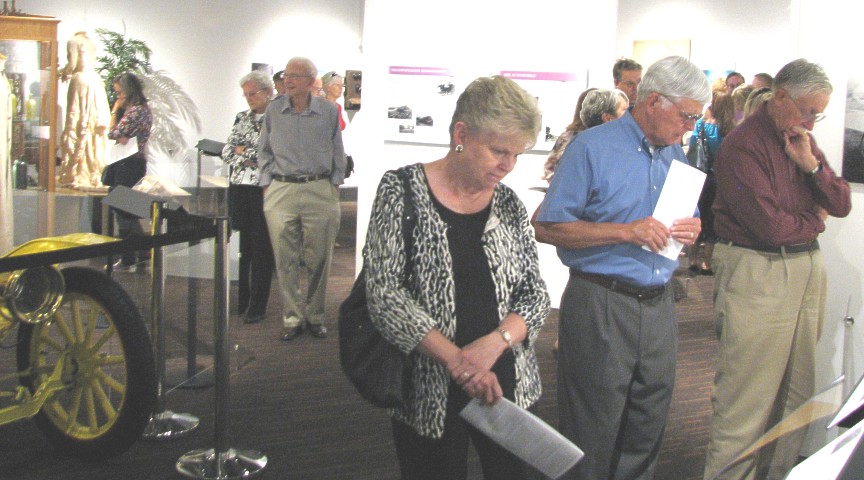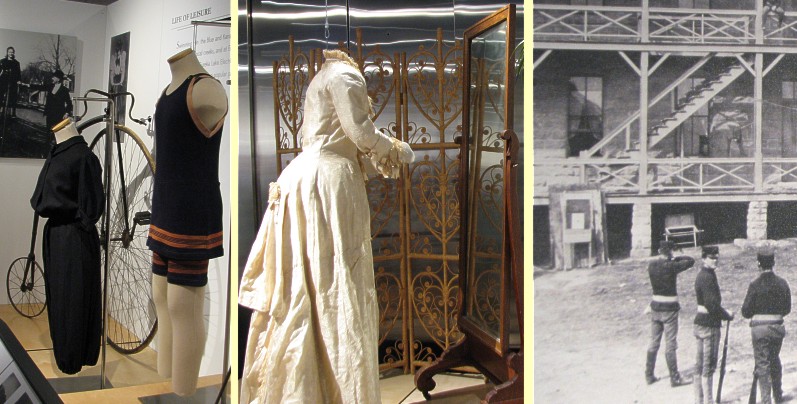
Kansas Snapshots by Gloria Freeland - Sept. 14, 2012
Forces shape a town, a fort, a university - and an exhibit!
Large photographs document the early history of Manhattan, Fort Riley and Kansas State University. A yellow Model T Ford and a life-size fiberglass horse representing the U.S. Cavalry are among the largest items. Smaller artifacts include a silk wedding gown, a kitchen cabinet, an 1896 penny-farthing (high-wheeled) bicycle, medicine bottles, a sewing kit, an 1856 map of Manhattan, and a ballot box.
All of these are part of the 100 items on display at the Flint Hills Discovery Center in Manhattan for its exhibition "Forces: The Shaping of Manhattan, Fort Riley, and Kansas State University." It will be available to visitors until Jan. 13, 2013 and shows the history of the town, the fort and the university from about 150 years ago to the advent of World War I.
As a history buff and organizer of special events myself, I have some appreciation of the difficult task of selecting items for such an exhibit. In 2010, I had a taste of what was involved when I planned a week-long display of artifacts related to the centennial of K-State's journalism school.
But the "Forces" exhibit required the cooperation of several partners over an 18-month period. One of the partners, the Riley County Historical Museum, has over 50,000 artifacts. Only 60 of them ended up in "Forces."
Cheryl Collins, director of the Museum, and Corina Hugo, the museum's curator of collections, agreed that the process was arduous, but rewarding and fun.
So how do you go about selecting photos and documents and artifacts to explain the 150-year history of a town, a fort and a university?
The partners - the U.S. Cavalry Museum and Directorate of Public Works at Fort Riley; the Riley County Historical Museum; the Morse Department of Special Collections and Historic Costume and Textile Museum at K-State and the Discovery Center - started working in the spring of 2011 to brainstorm themes they wanted to include. This continued for about a year, first with face-to-face visits, then conference calls, then emails. Principal funding for the exhibit was provided by the Kansas Humanities Council.
In the meantime, staff members from each entity began gathering the information they needed to create the historic time line and to establish major topics and sub-topics.
Researching the collections came next, and preliminary artifacts and photographs were identified from that research. Each participating institution proposed possible objects, and discussions continued after members visited each others' collections.
Cheryl said each staff looked at themes and went for items that illustrated them.
The Riley County museum staff cleared a large room for the preparation of the artifacts. More work was needed to find pertinent documentation. Then they cleaned, measured, photographed and catalogued items. They also made condition reports and, in some instances, had to carefully remove old labels - some stuck directly on objects with glue or adhesive tape.
Corina said the tape and glue were bad for the artifacts, but added that dust is one of the worst enemies. "It will even etch glass if you're not careful," she said.
Information for selected items was then entered into the museum's Past Perfect database, a software program that has the capability of connecting items with stories, photos and additional information.
While some staff members prepared the objects, others made labels. They also had to complete loan forms with valuation reports for insurance purposes.
Professional movers, along with the help of museum staff, moved larger items to the Discovery Center. Smaller items were put into boxes and transported by museum staff.
After all that, there was still the job of actually putting the exhibit together.
I doubt many people will have any idea of the amount of work and time it took. It indeed took many forces to create "Forces."

Visitors browsing the "Forces" exhibit.

Left: A bicycle and leisure clothing; middle: a wedding dress; right: Fort Riley soldiers sharpening their rifle skills.
Comments? [email protected].
Earlier columns from 2012 may be found at: 2012 Index.
Links to previous years are on the home page: Home